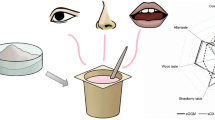Abstract
In the asparagus-processing industry, the by-products constitute around 50% of the total weight. These by-products are rich in fibre and bioactive compounds which could be advantageously employed in human nutrition. In the present work, yogurts were enriched with fibre obtained from the non-edible part of asparagus shoots to assess how the method of extraction (water or ethanol) and then drying (oven or lyophilisation) affects its performance. Fibre incorporation increased the consistency of the yogurts (higher η, G′, G″), especially if the fibres had been extracted in ethanol and lyophilised. However, there were no significant changes in the viscoelastic behaviour (tan δ) for any of the fibre types. Fibres diminished the clarity and imparted a yellow-greenish colour to the yogurt, which also varied depending on the method of extraction and drying, the yogurts with water-extracted fibres being more colourful. The sample more liked according to a consumer test was the yogurt containing water-extracted and oven-dried fibre for aroma, taste, texture, and overall acceptance, and ethanol-extracted and lyophilised for colour. The consumer panel scored all the samples around to the neutral point “neither like nor dislike”, demonstrating that fibre obtained by all methods were equally compatible with yoghurt enrichment.


Similar content being viewed by others
References
Fernández-García E, McGregor JU (1997) Food Res Technol 204:433–437
Lario Y, Sendra E, García-Pérez C, Fuentes E, Sayas-Barberá J, Fernández-López J, Pérez-Álvarez JA (2004) Innov Food Sci Emerg 5:113–117
García-Pérez FJ, Sendra E, Lario Y, Fernández-López J, Sayas-Barbera E, Pérez-Alvárez JA (2006) Milchwissenschaft 61(1):55–59
Dello Staffolo M, Bertola N, Martino M, Bevilacqua A (2004) Int Dairy J 14:263–268
Vinson JA, Hao Y, Su X, Zubik L (1998) J Agric Food Chem 46:3630–3634
Pellegrini N, Serafini M, Colombi B, Del Rio D, Salvatore S, Bianchi M, Brighenti F (2003) J Nutr 133:2812–2819
Makris DP, Rossiter JT (2001) J Agric Food Chem 49:3216–3222
Nindo CI, Sun T, Wang SW, Tang J, Powers JR (2003) Eur Food Res Technol 36:507–516
Sims IM, Cairns AJ, Furneaux RH (2001) Phytochemistry 57:661–668
Sims IM (2004) Phytochemistry 63:351–359
Rodríguez R, Smith AC, Waldron KW (2002) J Agric Food Chem 50(11):3197–3203
Rodríguez R, Jaramillo S, Guillén R, Heredia A, Jiménez A, Fernández-Bolaños J (2005) J Sci Food Agric 85(6):971–978
IDF, International Dairy Federation (1991) IDF/ISO Standard 150:1991 Yogurt. Determination of titratable acidity
Schramm G (2003) A practical approach to rheology and rheometry. Thermo Electron, Karlsruhe
ISO, International Organization for Standarization (1988) Sensory analysis. General guidance for the design of test rooms. ISO 8589:296 1988. Geneva, Switzerland
Francis FJ, Clydesdale FM (1975) Food colorimetry: theory and applications. The Avi Publishing Company, Westport
Doublier JL, Cuvelier G (1996) Gums and hydrocolloids: functional aspects. In: Eliasson AC (ed) Carbohydrates in Food. Marcel Dekker, Inc., New York
Portela-Palacios A, Sosa-Morales ME, Vélez-Ruiz JF (2005) J Texture Stud 36:333–349
Antwiwaa C, Nti P, Mateko L (2003) Int J Consum Stud 22(3):181–184
Acknowledgments
Special thanks to Danisco Specialities, Madrid, Spain, for the supply of the ferment. The authors are also indebted to Fondo Social Europeo for financing the contract of author T. Sanz in the program I3P from CSIC and to Generalitat Valenciana for financial support (Project GV/2007/246).
Author information
Authors and Affiliations
Corresponding author
Rights and permissions
About this article
Cite this article
Sanz, T., Salvador, A., Jiménez, A. et al. Yogurt enrichment with functional asparagus fibre. Effect of fibre extraction method on rheological properties, colour, and sensory acceptance. Eur Food Res Technol 227, 1515–1521 (2008). https://doi.org/10.1007/s00217-008-0874-2
Received:
Accepted:
Published:
Issue Date:
DOI: https://doi.org/10.1007/s00217-008-0874-2




